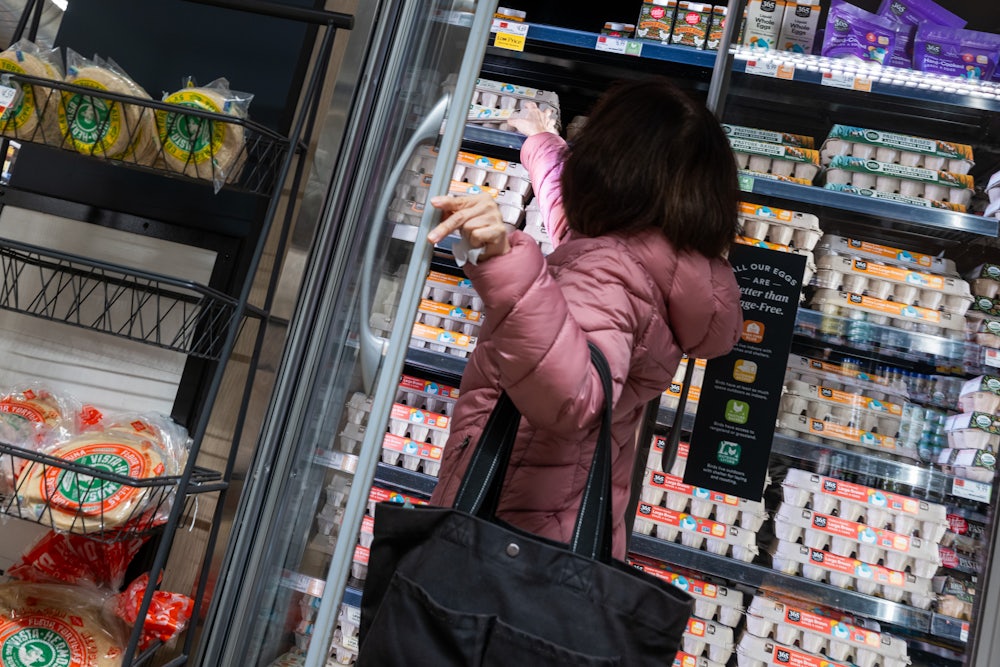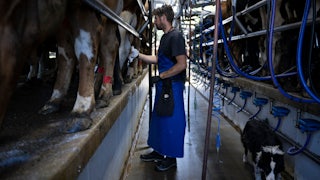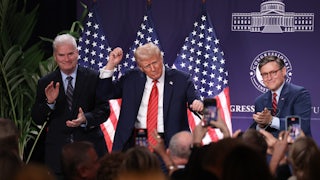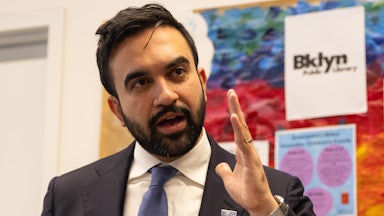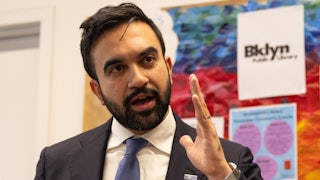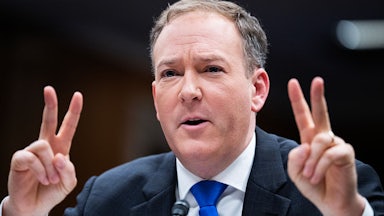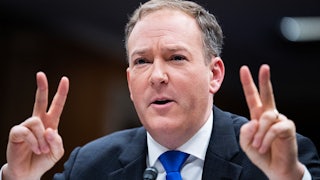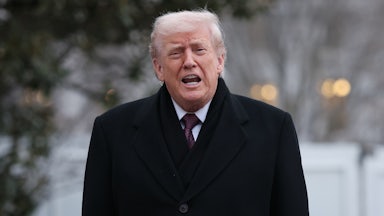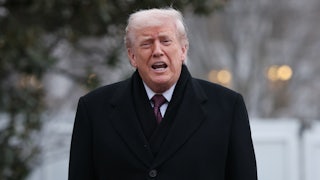The H5N1 avian flu outbreak has killed close to half a billion poultry worldwide, infected hundreds of wild bird and mammal species, and jumped to dairy cows in the United States. From birds and cows it has jumped, directly or indirectly, to at least 67 Americans, one of whom has died. The virus also likely helped Donald Trump win the election.
Over the past two years, H5N1 has been responsible for the deaths of over 100 millions chickens in the United States, many of them egg-laying hens. This has driven egg prices to historic highs. On the eve of November’s election, eggs were on average 71 percent more expensive than a year earlier. Eggs are such staples of the American diet that their price has become something of a referent for inflation as a whole. Trump campaigned promising to bring egg prices down “on Day One,” and some pundits blamed supermarket prices for Biden’s ultimate defeat.
Now, ongoing egg price increases are becoming an early thorn in the Trump administration’s paw, with the White House press secretary shunting blame for them onto Joe Biden, during the administration’s first press conference, and critics like Senator Elizabeth Warren calling on the government to implement policies they claim would reduce egg prices.
But the problem with this fixation with making eggs cheap again is that cheap eggs created this problem in the first place.
Americans are addicted to eggs, each person eating on average about 275 every year. This number has been rising steadily over the past few decades, buoyed by generally low prices. Eggs tend to be cheap for two reasons. First, retailers often sell them at or even below wholesale cost, using them as so-called loss leaders. By selling staples like eggs so cheaply, they attract customers into their stores where they will spend money on other products off which stores will profit. Second, virtually all of the 100-or-so billion eggs produced annually in the United States come from factory farms. There, in giant sheds that can house over 100,000 chickens each, hens are stuffed row upon row into tight battery cages, where they will spend the entirety of their short lives never seeing the sun or scratching in the dirt or even being able to comfortably spread their wings, popping out eggs until their bodies are worn out and they’re sent to slaughter. Not only is this an animal welfare travesty, but cramming so many virtually genetically identical birds of the same breed into such tight quarters makes factory farms hotbeds of disease.
For decades, public health experts have feared that the next big pandemic would originate in poultry. In an eerily prescient 2007 article in the American Journal of Public Health titled “The Chickens Come Home to Roost,” published during a global avian flu outbreak, David Benatar wrote that the next global influenza pandemic would likely start with an avian influenza. “Much human suffering resulting from zoonotic diseases,” Benatar stated bluntly, “could probably have been avoided had humans treated animals better.” Reducing the risk of zoonotic outbreaks in the food system, mostly by reducing land clearing for crops and moving away from the factory farming of animals, is a lesson we should have learned from previous avian flu outbreaks and from the 2009 swine flu outbreak. And it should have been driven home by the scope and scale of the human and economic impact of the Covid-19 pandemic.
Instead, meat, dairy, and egg consumption increased. People may claim to care about animal welfare and avoiding future pandemics, and many people surely do, but in the aggregate shoppers vote against these interests with their dollars by, for instance, buying cheap eggs. Economists call this revealed preference: Look at what people actually buy, and you’ll understand what they actually value. And consumers, understandably, value price, taste, and habit. Markets respond by trying to give consumers what they want, and in this case that means funneling money to factory farms.
What consumers buy, in turn, determines both how inflation is measured and how it’s experienced. The Bureau of Labor Statistics’ consumer price index is a tool for measuring inflation. It compiles the costs of a wide range of good most Americans buy and compares the cost of this basket over time. But this tool evaluates not just what consumers buy but how much, so if consumers eat a lot of eggs, the price of eggs will be weighted heavily in calculating the CPI. As the Brookings Institute put it, in an article written before the current outbreak of H5N1, “Americans spend more on chicken than tofu, so changes in the price of chicken have a greater impact on the CPI.” In the face of a supply shock like H5N1, egg prices rise much faster than those of other goods, which not only drives up CPI but makes the difference in prices very obviously visible to shoppers, even though most of them don’t connect the price hikes to a disease ravaging farms thousands of miles away from their supermarket. Put differently, H5N1 is an invisible inflationary disease.
And that, in turn, likely contributed to another set of revealed preferences: votes. Studies have long suggested that inflation harms incumbents, and a study published as a pre-print a week after the election suggested inflation might specifically have hurt Kamala Harris because it undermined voters’ faith in Democrats as stewards of a stable economy. This made Harris a victim of a more general global trend in 2024 of inflation undermining incumbent candidates in national elections.
Not that presidents can do all that much to directly affect food prices over the short term. Even proposals like Elizabeth Warren’s, which focus mostly on antitrust regulations that would introduce competition into the food sector, wouldn’t guarantee cheaper egg prices. Addressing zoonotic disease is less a matter of economic stewardship than it is of agricultural regulations.
A 2023 report co-authored by experts from Harvard Law School and New York University, released as the current H5N1 outbreak was already underway, highlighted America’s particular vulnerabilities to new zoonotic diseases, including via the country’s spotty regulatory environment. It concluded, “The United States has no comprehensive strategy in place to address the threat of zoonotic disease. There are serious regulatory deficiencies across almost every animal industry.” Instead, the U.S. response has relied on the blunt instrument of culls and government payouts.
When H5N1 or a similar disease is found in a flock of birds—and “flock” refers to the tens if not hundreds of thousands of birds in a given production facility—all those birds are culled. The site is disinfected, and then the sheds are crammed full of new hens as soon as possible to get the supply of eggs flowing again. When I wrote earlier that H5N1 is “responsible for” over a hundred million deaths, this is what I meant: Many birds were killed by the disease, but the majority were culled to stop the disease from spreading. Poultry and egg companies, in turn, are indemnified for the value of their birds they cull by the federal government through the U.S. Department of Agriculture’s Animal and Plant Health Inspection Service, or APHIS. Through January 2025, APHIS had paid out over a billion dollars in indemnity payments. These payments make it easier for companies to restart their operations, increasing the supply of eggs in the market but also increasing the risk for new outbreaks. Many companies have received multiple government bailouts after multiple outbreaks. In other words, existing approaches incentivize rather than mitigate risk.
As H5N1 ravaged the poultry and egg industries and then made the jump to cows, leading to culls of infected dairy cattle and infections of dairy workers, the reaction from regulators was slow and patchy, with testing and reporting of the disease varying from state to state and from farm to farm. And even as the USDA, at the time led by former dairy industry lobbyist Tom Vilsack, released funds to the industry to contain spread of the disease, one exposé suggested that the USDA allowed for “an unspoken ‘don’t test, don’t tell’ policy among dairy farmers.”
Actually reducing zoonotic risk in the food system probably means more expensive eggs. In the short term, tighter biosecurity protocols and more monitoring by state agencies (and likely even more culls as more positive cases are detected) would slow and constrain production, driving prices up. The same would happen with any broader, long-term fiscal policies, like a proposal made by a team of European economists for a “zoonotic tax” to be levied on industries that present zoonotic risks. The tax would be applied, for example, to egg farms to disincentivize production or help raise the funds for a response to any potential disease outbreak. This is similar to the wide range of proposals that have suggested that food prices should internalize the costs of their broader environmental and health impacts, which would particularly affect meat, eggs, and dairy. None of this would be politically popular. Indeed, the animal agriculture industry is clamoring for less regulation, and consumers are clamoring for cheap eggs.
The late literary scholar Lauren Berlant coined a particularly useful term for understanding many aspects of the modern predicament: cruel optimism. “A relation of cruel optimism exists,” she writes, “when something you desire is actually an obstacle to your flourishing.” The cheap egg is an untenable desire; where H5N1 and perhaps others of our political troubles hatch.
So perhaps we should shift our desires. And “we” includes critics of the administration making cheap eggs a rallying cry for the resistance. Why would we tie our notions of economic well-being to something so risky? As David Benatar suggested almost two decades ago, perhaps the most obvious thing to do is to not put things that risk another zoonotic pandemic in our shopping baskets and in our statistical baskets of goods. To the extent we can, we should derisk the food system by minimizing our reliance on food sources that can act as vectors of zoonotic disease and which, in turn, tend to be the most prone to supply shocks caused by disease and therefore more inflationary. Oatmeal, unlike eggs, is still a very affordable way to start the day. So is a tofu scramble.
